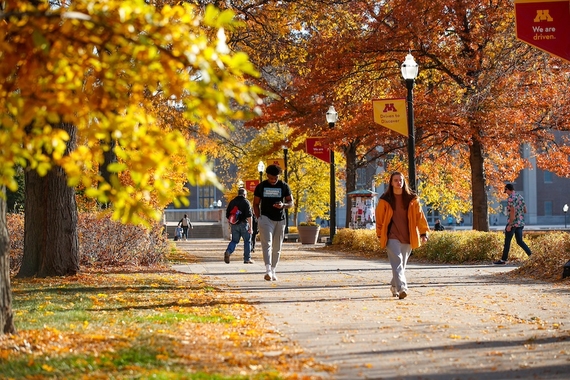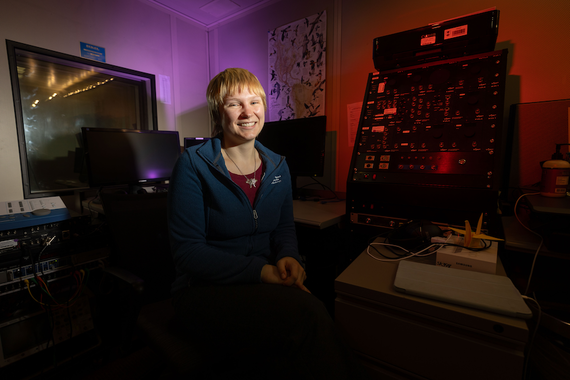Speech with ALS: An Art and A Science
“It’s a close knit community,” says Rebecca Lulai of the speech-language-hearing sciences department here at the University of Minnesota-Twin Cities. Lulai began her new position as director of clinical programs for speech pathology this past fall. She started her career at the University of Minnesota in 2006 as a clinical supervisor after spending some time in the field working as a speech pathologist. Lulai returned to education because, as she explains, “I always felt like I wanted to go back to the University setting.”
As the new director of clinical programs in speech pathology for the University, Lulai oversees the many clinics that are housed in the Julia M. Davis Speech-Language-Hearing Center here on campus. She also works with graduate students to ensure their education is an accurate reflection of their future careers. “The graduate program at the University of Minnesota is specialized. When you graduate, you know exactly what a speech pathologist does because you’ve been doing it for the past two years,” Lulai explains.
Clinics are a big part of that graduate school experience, and they contribute to the 100% job placement rate that students who graduate with a master’s degree in speech pathology from the U are rewarded with. Clinics are also one of the main reasons that Lulai accepted the position, as she didn’t want to completely sacrifice patient care. “What I really like is that this position allows me to be in the clinic and working with the patients as well as doing the administrative work,” Lulai says.
A Precious Bank
Although Lulai oversees all of the different clinics in speech pathology, she has taken a special interest in one specific program: the ALS Voice Bank. Amyotrophic lateral sclerosis (ALS), otherwise known as Lou Gehrig’s disease, is a progressive neurodegenerative disease. The ALS Voice Bank Project is a program that allows ALS patients to have their voices recorded and preserved for when they eventually lose the ability to talk. The project was created at the University of Delaware, but it comes to life right here on the Twin Cities campus. “We essentially serve as the recording studio for this project,” Lulai explains.
Patients in this program are in for a long process, but the reward is well worth their effort. Lulai recalls, “The recording process is not easy. It takes about 8 to 10 hours total depending on the patient, and lots of graduate student help.” After the voice recording is completed, it is sent back to Delaware where pieces of it are synthesized together to create an artificial voice which closely resembles that of the patient. The voice is then transferred to speech generation applications and can be used on smart devices.
Lulai became intrigued by this project because it allows ALS patients to preserve a part of themselves. “Most ALS patients do eventually lose their voices, and right now the existing speech generation programs are monotone and impersonal.” This voice recording project allows ALS patients to still express their ideas with emotion even if they are using a speech generator. The recording takes a lot of time and effort from Lulai and various graduate students, but it is rewarding work. “Everyone that comes through is just so appreciative and thankful for the opportunity,” Lulai reveals.
The speech bank program started small, but the University of Minnesota has now served approximately 25 ALS patients and is receiving national attention for it. This is, in part, due to a generous donation by the regional ALS Association, which has been encouraging ALS patients to take advantage of this opportunity by covering the costs of the recording. For some patients, the cost of generating a voice could be upwards of $1000, but thanks to the ALS Association, it is free in Minnesota. This past spring, the Steve Gleason Foundation announced that it would also be covering the lab fees for the voice bank project across the country.
Where Art and Science Meet
“This voicebank project, and all of speech pathology really, is an art and a science. You’re using these scientific principles and evidence-based practices, but you’re actually working with a human being,” says Lulai. The ability to use her knowledge to engage with the community is what drew Lulai to the field of speech pathology and it’s what keeps her going everyday. Even in her new role as director of clinical programs, Lulai gets the opportunity to see patients regularly. “By the nature of the professional program we are constantly engaging with the community. It is something that every one of us does on a daily basis, even in a university setting,” Lulai explains.
Lulai is just settling into the director role, and she does not expect to leave the University of Minnesota anytime soon because she “has some things she wants to do.” “My goal is to build that clinic to research relationship,” she explains. Lulai hopes to get even more faculty members, researchers, and graduate students working in clinics and research. Lulai, with the help of projects like the ALS Speech Bank, is growing the world of speech pathology one recording at a time.
This story was written by an undergraduate student account executive in CLAgency. Meet the team.



